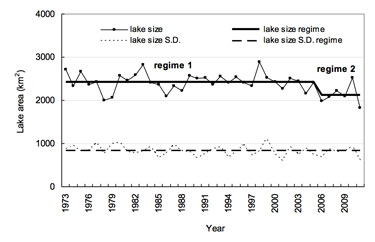Insight: Why Is Poyang Lake Shrinking?
Updatetime:2013-04-09From:
【Enlarge】【Reduce】
China's largest freshwater lake, Poyang Lake, has been shrinking at an alarming pace in recent years. A study published in Environmental Research Letters (ERL), sheds new light on the factors responsible.
 |
| Poyang Lake, China's largest freshwater lake, underwent a regime shift in 2006. Figure 3 from Recent declines in China's largest freshwater lake: trend or regime shift? Yuanbo Liu et al. 2013 Environ. Res. Lett. 8 014010 |
With the aid of multi-temporal satellite images and hydrological data, the research group constructed a four-decade record of lake size. They found an abrupt change in size in 2006, indicating that the lake had shifted regimes (see figure). This shift has many different implications over the long term, which will undoubtedly be important for policy- and decision-makers. The lake area decreased by 311.6 km2, with 2433.7 km2 under the first regime and 2122.1 km2 under the second.
"This shrinkage is also ecologically important," said Liu, "because the Poyang Lake wetland is a reserve of international importance for cranes and many other water birds."
Normally, the size of a lake depends on how much water comes in and goes out of the water body. However, in the case of Poyang, basin-scale precipitation and outflow did not show any significant trend or abrupt change. Basin-scale evapotranspiration also increased in addition to an abrupt change in 1998. None of these factors can thus fully account for the regime shift in the lake.
The regime shift is thought to have been triggered by the weakened blocking effect of the Yangtze River, which controls the outflow of the lake. In addition to climate change upstream of the Yangtze, the regime change is most probably linked to the Three Gorges Dam – the world's largest dam, built upstream of the Yangtze River in 2003.
How climate change and the Three Gorges Dam have affected the Yangtze River and influenced Poyang Lake outflow are issues that require further study. Such analyses will greatly improve our understanding of how important large-scale hydrological constructions, such as dams, are in a changing climate. (environmental research web)
Yuanbo Liu is a scientist at the Nanjing Institute of Geography and Limnology of the Chinese Academy of Sciences in Nanjing, China. He is the leader of a research group working on quantitative hydrology remote sensing. His research includes terrestrial evaporation, hydroclimatic change, scale and scaling, and quantitative retrieval of hydroclimatic parameters from satellite remote sensing.
Appendix




